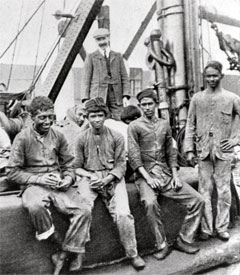The lives of lascars are of more interest today than ever before –

for the very good reason that they were possibly the first Asians and Africans to participate freely, and in substantial numbers, in a globalized workspace.
They were among the first to travel extensively; the first to participate in industrial processes of work; the first to create settlements in Europe; the first to adapt to clock-bound rhythms of work-time (the shipboard regime of four-hour work-shifts, or watches, was one of the most exacting disciplinary regimes ever invented); and they were the first to be familiar with emergent new technologies (nautical engineering being itself one of the pioneering technologies of the industrial age). Not least, the lascars were among the first Asians to acquire a familiarity with colloquial (as opposed to book-learned) European languages.

Lascars were thus in every sense the fore-runners of today’s migratory computer technicians, nurses, high-tech workers, and so on.
Indeed they faced many of the same problems that contemporary Asian and African workers face, with their Western counterparts doing everything possible to limit their access to the most profitable labour markets. The British Navigation Laws of 1814 and 1823, for example, imposed rigid restrictions on the employment of lascars and played no small part in crippling the Indian shipping industry, which had shown itself to be fully capable of competing with its British counterpart.[i]
Today, thanks to the work of pioneering scholars like Isaac Land, Rozina Visram and Michael Fisher, a great deal more is known about lascars than was the case even ten years ago.[ii] We know for instance, that lascars were a substantial presence in London even in the seventeenth century, and possibly even earlier; we know that they could, by law, be paid a fraction of a white sailor’s wage and that to hire them was an easy way to expand profit margins. We know that in many Asian ports, well-organized chain gangs recruited sailors through such methods as kidnapping and debt-bondage. We know that contractors would sometimes sell their kinsmen’s children into virtual servitude and that often, on reaching their destination, unscrupulous shipmasters would abandon these young men and boys on the streets of London and Glasgow.
Yet it remains true that that much of what is known about lascars pertains to the shore: about their life at sea we know very little. Like many paperless migrants in the West today, lascars in the age of sail were probably suspicious of public scrutiny, so it behooves us to note that theirs is not the least of the many curtains of silence which we seek to pierce when we inquire into their lives.
But how, for example, in the Babel of tongues that was a lascar-manned sailship, did people communicate? Or, to put it differently, how on earth could they afford not to?
____________________________________________________
[i] For more on the curtailment of the Indian shipping industry, see Anne Bulley’s The Bombay Country Ships, 1790-1833 (Richmond, 2000), p.239, Asiya Siddiqi’s The Business World of Jamsetjee Jeejeebhoy, Indian Economic & Social History Review, vol. 19, Nos. 3-4, July-Dec. 1982, pp. 301-24 & Amalendu Guha’s Parsi Seths as Entrepreneurs: 1750-1850, Economic and Political Weekly, V, No. 35, pp. M-107-15, 1970.
[ii] See for example: Rozina Visram’s Ayahs, Lascars and Princes: Indians in Britain, 1700-1947, Pluto Press, London, 1986, & Asians in Britain: 400 Years of History, Pluto Press, London, 2002; Michael H Fisher’s Counterflows to Colonialism: Indian Travellers and Settlers in Britain, 1600-1857, Permanent Black, 2004; & Isaac Land’s Customs Of The Sea: Flogging, Empire, And The ‘True British Seaman’ 1770 To 1870, Interventions, 3:2, 169-185, 2001; ‘Sinful Propensities’: Piracy, Sodomy, and Empire in the Rhetoric of Naval Reform in Britain and the United States, 1770-1870, (forthcoming as a chapter in Discipline and the Other Body, Duke University Press; & Bread and Arsenic: Citizenship from the Bottom Up in Georgian London, Journal of Social History, Volume 39, Number 1, pp. 89-110, Fall 2005.

To look at them in the picture, they do not look like today’s techies but yes they sound like forerunners of globalized world.
I love reading these glimpses into those persons’ lives – in spite of reading about them as characters in your two books, it didn’t explain the things you mention here!